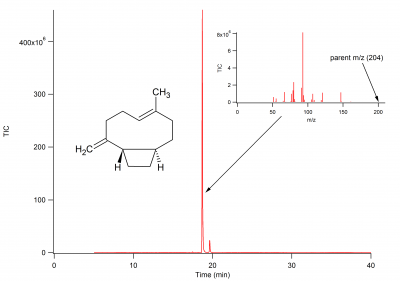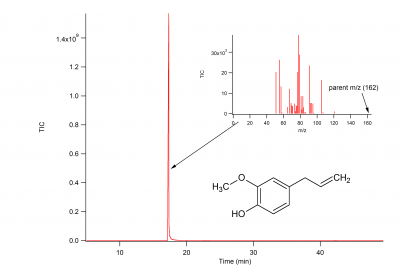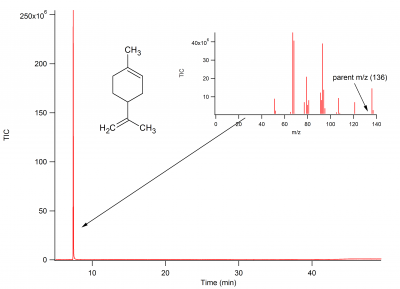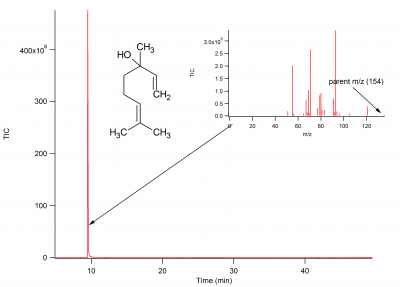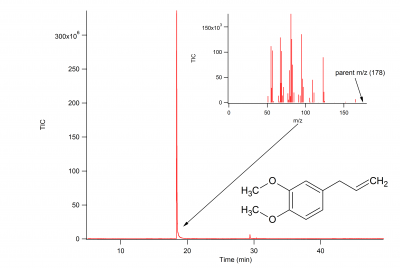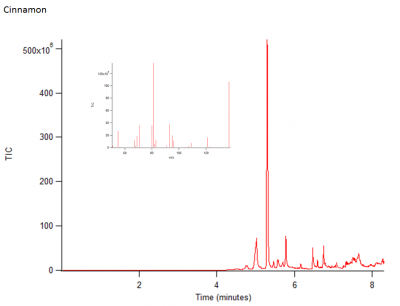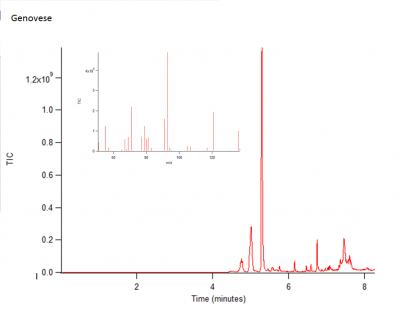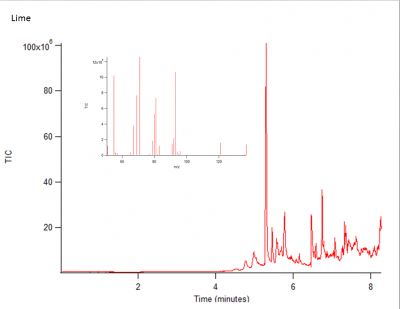Difference between revisions of "SAHounsve Fall 2017"
| (3 intermediate revisions by the same user not shown) | |||
| Line 32: | Line 32: | ||
===Results=== | ===Results=== | ||
Pictures of chromatographs and mass spectrums are shown. | Pictures of chromatographs and mass spectrums are shown. | ||
| − | [[File:b_car_gcms_1.png|400px|thumb|left|Figure 1: B-caryophyllene standard]] [[File: | + | [[File:b_car_gcms_1.png|400px|thumb|left|Figure 1: B-caryophyllene standard]] [[File:eu_gcms_1.png|400px|thumb|left|Figure 2: Eugenol standard]] [[File:lim_gcms_1.png|400px|thumb|left|Figure 3: Limonene standard]][[File:lin_gcms_1.png|400px|thumb|left|Figure 4: Linalool standard]] [[File:meug_gcms_1.png|400px|thumb|left|Figure 5: Methyl eugenol standard]] |
[[File:cin_fresh_bag_1.png|400px|thumb|left|Figure 6: Sniffed cinnamon basil]][[File:gen_fresh_bag_1.png|400px|thumb|left|Figure 7: Sniffed genovese basil]][[File:lemon_fresh_bag_1.png|400px|thumb|left|Figure 8: Sniffed lemon basil]][[File:lime_fresh_bag_1.png|400px|thumb|left|Figure 9: Sniffed lime basil]][[File:opal_fresh_bag_1.png|400px|thumb|left|Figure 10: Sniffed opal basil]] | [[File:cin_fresh_bag_1.png|400px|thumb|left|Figure 6: Sniffed cinnamon basil]][[File:gen_fresh_bag_1.png|400px|thumb|left|Figure 7: Sniffed genovese basil]][[File:lemon_fresh_bag_1.png|400px|thumb|left|Figure 8: Sniffed lemon basil]][[File:lime_fresh_bag_1.png|400px|thumb|left|Figure 9: Sniffed lime basil]][[File:opal_fresh_bag_1.png|400px|thumb|left|Figure 10: Sniffed opal basil]] | ||
Latest revision as of 19:18, 26 September 2017
Chemistry/Biochemistry Research 430
Fall 2017
Selene Hounsve
Senior Biochemistry Major
Research Times
Mon/Wed: 8-10 AM
Tue: 2-5 PM
Proposed Research Project
Extraction, characterization, and application of essential oils from various basil. The characterization of the oils will be done using GC-MS.
Project Title
Extraction and Characterization of Essential Oils from Basil Varieties
General Information
Advisor: Dr. Bradley E. Sturgeon
Proposal
Essential oils are synthesized via secondary metabolic pathways and have a role in plant defenses against pathogens and herbivores, in plant reproduction, attraction of pollinators, and in thermotolerance. Essential oils can be classified into two different groups based on their metabolic synthesis: terpenoids, which are monoterpenes and sesquiterpenes; and low molecular weight phenylpropanoids.
Herbs are utilized for their distinctive fragrance and flavors. This flavor and smell stems from the essential oils, which get their name for embodying the essence of the plant’s smell. When choosing herbs to enhance smell and flavor it is important noting differences in essence between varieties of species. For instance, there are more than 350 species of thyme with an untold amount of cultivated varieties, all bearing slightly different essences and oils.
The goal of this research is to extract the oils of cultivated varieties of basil and make a chemotype table. The analysis will be done via gas chromatography and will employ standards of these chemicals as a tool for identifying compounds. The basis for the expected chemical makeup will be based on Tucker and Thomas’ The Big Book of Herbs: A Comprehensive Illustrated Reference to Herbs of Flavor and Fragrance.
Instruments to be used
Steam Distillation, GC-MS, Sniffer
Experimental
GC-MS standards were created by 2uL of compound in 2mL methylene chloride. Compounds were eugenol, methyl eugenol, B-caryophyllene, S-limonene, and linalool.
Conditions for run were 50-250ºC, (4.5ºC/min), held 50ºC (5 min), and 90% split.
The standards were then run on GC-MS to identify the peaks on their chromatograph and m/z of fragmentation on mass spectrum.
Currently, using sniffer to take in gas from standards and basil for chromatograph and mass spectrum.
Results
Pictures of chromatographs and mass spectrums are shown.
Discussion
The sniffer data has yet to be interpreted until standards are sniffed by GC-MS.
Conclusion
No conclusions made at this time.
References
1. Husnu Can Baser, K, and Gerhard Buchbauer. Handbook of Essential Oils: Science, Technology, and Applications. 2nd ed., CRC Press, 2016.
2. Marotti, Mauro, et al. "Differences in Essential Oil Composition of Basil (Ocimum basilicumL.) Italian Cultivars Related to Morphological Characteristics." Journal of Agricultural and Food Chemistry 44.12 (1996): 3926-929. American Chemical Society. Web. 1 July 2017.
3. Samadi, Mahtab, et al. “Assessing the kinetic model of hydro-Distillation and chemical composition of Aquilaria malaccensis leaves essential oil.” Chinese Journal of Chemical Engineering, vol. 25, no. 2, 2017, pp. 216–222. ScienceDirect. Web. 5 Sept. 2017.
4. Tucker, Arthur, and Thomas DeBaggio. The Big Book of Herbs: A Comprehensive Illustrated Reference to Herbs of Flavor and Fragrance. Interweave Press Inc, 2000.
5. Viña, Amparo, and Elizabeth Murillo. "Essential Oil Composition from Twelve Varieties of Basil (Ocimum spp) Grown in Colombia." Sociedade Brasileira de Química 14.5 (2003): 744-49. Journal Brazilian Chemical Society. Web. 18 Apr. 2017.
Research pledge
I, Selene Hounsve, have read the Chem/Bioc 430 course syllabus and understand the general structure and expectations of the research program. The above material was prepared after consultation, and in conjunction with my research advisor.
